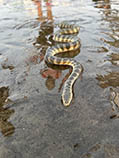Hydrophis schistosus Daudin, 1803
Beaked sea snake
Classification / Names Common names | Synonyms | CoL | ITIS | WoRMS
Not assigned | Squamata | Elapidae
Environment: milieu / climate zone / depth range / distribution range Ecology
Reef-associated; depth range 3 - 22 m (Ref. 78387). Tropical; 31°N - 58°S (Ref. 356)
Distribution Countries | FAO areas | Ecosystems | Occurrences | Introductions
Indo-West Pacific.
Length at first maturity / Size / Weight / Age
Maturity: Lm 74.5, range 47 - 101.5 cm Max length : 140 cm TL male/unsexed; (Ref. 801); common length : 110 cm TL male/unsexed; (Ref. 801)
Short description Morphology
Young has gray to black annuli, while juveniles has 45-55 transverse bars that may extend down the flanks with the lower body whitish and without pattern. Adults are uniform gray above, whitish below. Dark bars wider or as wide than paler interspaces.
Average length is 90 cm. The venom of this snake is said to be responsible for more serious and fatal bites than all other sea snakes combined and is considered to have the most toxic venom. Based on studies, the myotoxic phospholipase A from the venom causes myoglobinuria in mice (Ref. 88062). Usually occurs in clear shallow reef waters (Ref. 2357), and may travel about ten miles up tidal rivers (Ref. 88062). Also prefers estuarine conditions in Australia (Ref. 2357). Ovoviviparous (Ref. 801), with 4 to 9 young ones in a brood (Ref. 88062). Feeds on fish (Refs. 801, 88062).
Life cycle and mating behavior Maturity | Reproduction | Spawning | Eggs | Fecundity | Larvae
Main reference
References | Coordinator | Collaborators
Redfield, J.A., J.C. Holmes and R.D. Holmes. 1978. (Ref. 78387)
IUCN Red List Status (Ref. 130435)
Least Concern (LC) ; Date assessed: 15 February 2009
CITES status (Ref. 108899)
Not Evaluated
CMS (Ref. 116361)
Not Evaluated
Threat to humans
Venomous (Ref. 88062)
Human uses
Fisheries: of no interest
| FishSource |
Tools
More information
Internet sources
BHL | BOLD Systems | CISTI | DiscoverLife | FAO(Publication : search) | Fishipedia | GenBank (genome, nucleotide) | GloBI | Gomexsi | Google Books | Google Scholar | Google | PubMed | Tree of Life | Wikipedia (Go, Search) | Zoological Record
Estimates based on models
Preferred temperature
(Ref. 115969): 24.8 - 29.3, mean 28.5 (based on 3251 cells).
Resilience
(Ref. 69278):
High, minimum population doubling time less than 15 months (K=0.6-0.75).
Price category
(Ref. 80766):
Unknown.



